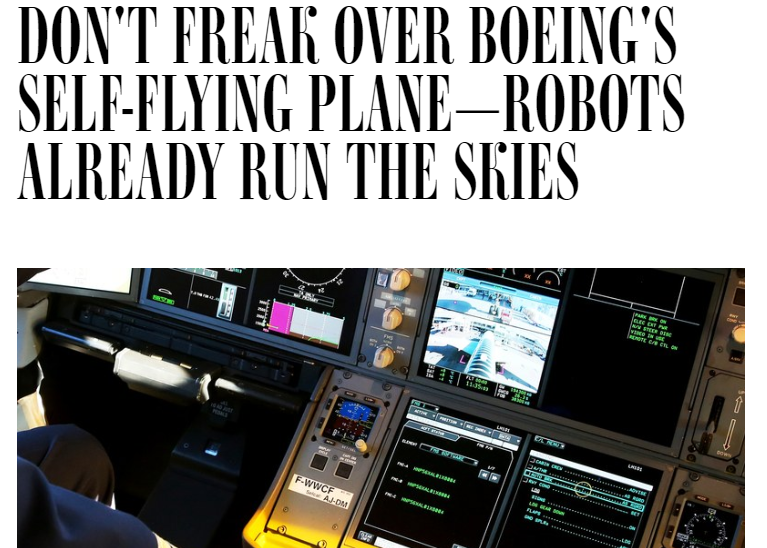A.I. murders 346 humans by deliberately crashing BOEING 737 MAX planes
With self-driving cars and trucks coming on fast, it’s only natural to wonder if self-flying planes might be next. In fact, the aviation industry is pushing to make autonomous passenger aircraft a reality — and sooner than you might think.
In the 1950s, it took five people to fly an airliner — two pilots, a flight engineer, a radio operator, and a navigator. By the 1960s, the radio operator and navigator were gone. In the 1990s, flight engineers disappeared. Given this trend, fully automated aviation may seem inevitable.
One motive for the trend, not surprisingly, is financial. A recent report released suggests that by transitioning to self-flying aircraft the aviation industry could save $35 billion a year.
06.09.2017 – BOEING JUST GOT into the autonomous aviation game, with the goal of building jetliners that fly themselves, no pilots required. “The basic building blocks of the technology clearly are available,” Mike Sinnett, Boeing’s vice president of product development, said ahead of the Paris Airshow.
–
The prospect of a pilotless passenger plane may strike you as crazy, even terrifying. But developing computer systems sophisticated enough to pull it off is well under way. Autopilot technology already does most of the work once a plane is aloft, and has no trouble landing an airliner even in rough weather and limited visibility.
Boeing wants to take another step toward taking humans out of the equation by developing artificial intelligence capable of making even more of the decisions pilots make. Sinnett says Boeing plans to test such a system in a simulator this summer, and in a real plane next year.

Whether air travelers are ready to board a pilotless plane is another matter. The same report found that only one in six passengers would feel comfortable in a fully automated plane.
Of course, passengers may not realize just how much a pilot’s job has already been automated. “On an average flight, the pilots manually control the plane for about three to six minutes, and the rest is autopiloted,” says Boeing. Some airlines don’t let their pilots fly manually once the plane has reached cruising altitude “because they understand that the autopilot is actually safer.”
Which brings up another consideration in the move toward pilotless airliners: safety.
03.10.2019 – A brand new Ethiopian Airlines Boeing 737 Max 8 (equipped with BOEING A.I. systems) crashed shortly after take off from Addis Ababa this morning on March 10, 2019 killing all 157 passengers & crew members onboard. The A.I. system called MCAS has been blamed for the fatal crash.
10.29.2018 – A brand new Boeing 737 Max 8 (also equipped with the BOEING A.I. systems) operated as Lion Air Flight 610 crashed into the Java Sea shortly after take off killing all 189 onboard. The A.I. system called MCAS has been blamed for the fatal crash.
The new 737 MAX’s comes with new A.I. system called MCAS (Maneuvering Characteristics Augmentation System), which didn’t exist on the previous generation of Boeing 737s. This was required because the aircraft had bigger engines than earlier models, providing up to 14% savings in fuel consumption. They are fitted further forward under the wings, which could potentially cause the plane to stall. In order to prevent this, Boeing engineers developed the new MCAS software.
The software tells the flight control system to change its Angle of Attack (AOA) downward if a stall risk is perceived, which the computer initiates automatically. The pilots would have no chance to intervene even if the autopilot is switched off.
On the aircraft, there is a sensor called the “Alpha Vane”. This sensor measures the AOA. There are two of them, on both sides of the plane.
This seems to be the problem. In the case of Flight 610, a faulty sensor sent false AOA data and MCAS took control of the aircraft. The system concluded that the AOA of the plane was over 40 degrees and pushed the aircraft’s nose down, causing a sharp dive into the Java Sea.
The initial data point out a similar situation in the case of Ethiopian Flight 302. The A.I. system called MCAS is to blamed for BOTH the fatal crashes killing all 346 humans.
“How do we maintain levels of safety that we enjoy today … when you’ve got an artificial intelligence-based system in the cockpit?” Greg Hyslop, Boeing’s chief technology officer, said in September at a conference at the Massachusetts Institute of Technology. “How do you show and certify that to be safe to the point where the flying public would say, ‘Yes, I trust that.’”

